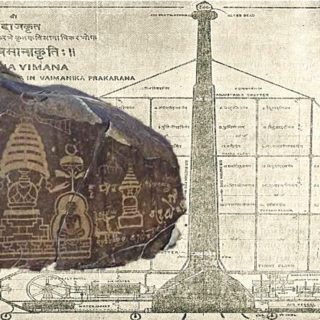Vimanas: Ancient Wisdom on Wings
ONE OF MANKIND’S OLDEST FASCINATIONS has been with the concept of flight. Recorded history cites the 1780s as the period when the human race, through the combined efforts of two Frenchmen (the Montgolfier brothers), rose to the air in a hot air balloon near Paris.
But researches into the hoary secrets of aviation believe that the knowledge of flight existed among ancient civilizations in Egypt, China, Peru and Columbia. However, India was perhaps the torchbearer of that glorious tradition, which many still consider a myth.
Part of the Mahabharata, the Bhagavad Gita is 10 times longer than Homer’s Iliad and Odyssey combined, and was written between the 5th and 2nd century BC. This ancient book contains numerous passages that speak of Gods who flew around in aerial vehicles or “flying chariots” called Vimanas that were armed with deadly weapons that had the capacity to destroy entire cities.
The Vimana has been described as a double-deck, circular aircraft which had portholes and a dome and was propelled by a yellowish-white liquid, possibly some sort of mercury compound. An extract says: “The Vimana is a weapon so powerful that it can destroy the Earth in an instant... it makes a great soaring sound, in smoke and flames. And on it sits Death.”
A passage from the Mahabharata reads: “A swift and powerful Vimana hurled a single projectile charged with all the power of the universe... an incandescent column of white hot smoke and flame as bright as 10,000 Suns, rose in all its splendor.”
The Ramayana itself is a work filled with material pointing to the knowledge of flight. Remember how the evil Ravana is said to have taken Sita to Lanka in a flying chariot?
Jain works too are packed with details of Vimanas like flight manuals and their control. For example, the Samara Sutradhara is a scientific treatise dealing with every possible angle of air travel in a Vimana. There are 230 stanzas dealing with the construction, take-off, cruising for thousands of miles, normal and forced landings, and even possible collisions with birds.
In 1875, the Vaimanika Sastra, a fourth century B.C. text written by Rishi Bharadwaj, using even older texts as his source, was rediscovered in a temple. It dealt with information on the steering, precautions for long flights, protection of the airships from storms and lightening, and how to switch the drive to ‘solar energy’ from a free energy source (which sounds like (anti-gravity). The sage referred to no less than 70 authorities and 10 experts on air travel in antiquity.
The Kebra Nagast, the holy book of the Ethiopians, says King Solomon from Biblical times had a flying vehicle in which he visited modern-day Pakistan, Iran and Tibet. Legend has it that Solomon was passionate about making maps of the places over which he flew. Mind-boggling, isn't it?
When Alexander the Great (356-323 B.C.) invaded India more than two thousand years ago, his historians chronicled that at one point they were attacked by ‘flying, fiery shields’ that dove at his army and frightened the cavalry. There was however, no loss of life or any other manner of damage reported.
Perhaps this timeless knowledge at our disposal has a message, in that, almost all of these civilizations destroyed themselves due to the abuse of their advanced technology. That’s something for us ponder about, is it not?
By Anand Balaji
Independent researcher and playwright Anand Balaji , is a i∀monǝ guest writer and author of Sands of Amarna: End of Akhenaten .
If you enjoyed my site or this article please consider making a donation your help is much appreciated.
https://paypal.me/pools/c/7ZWkzY5F0l







Comments
Post a Comment